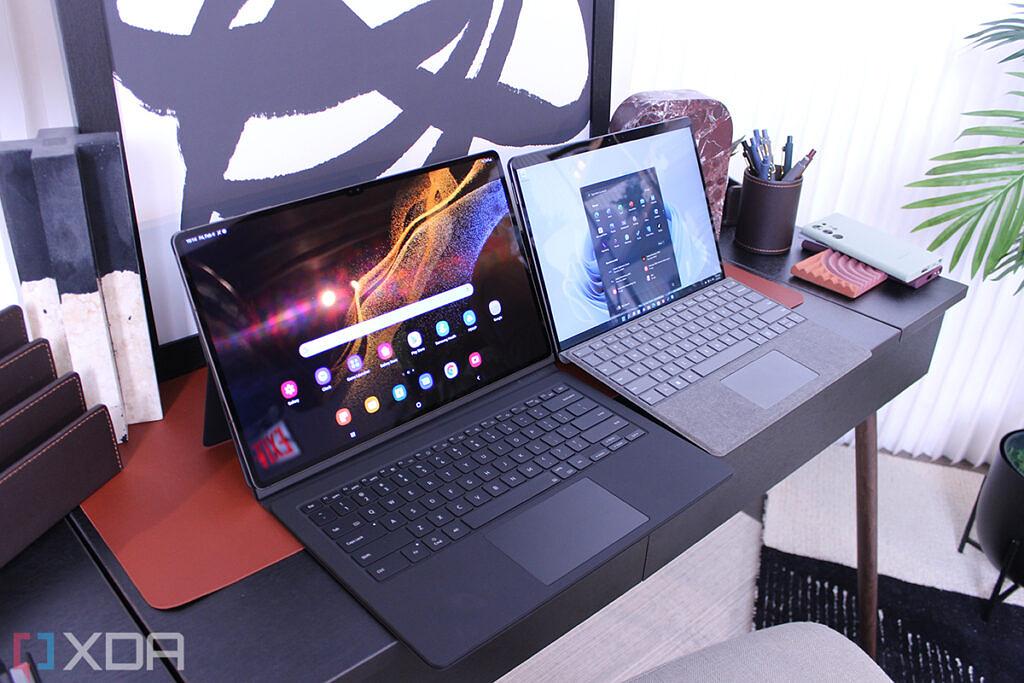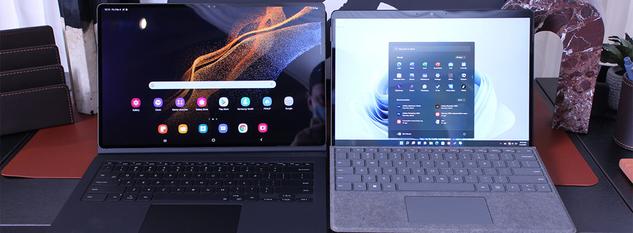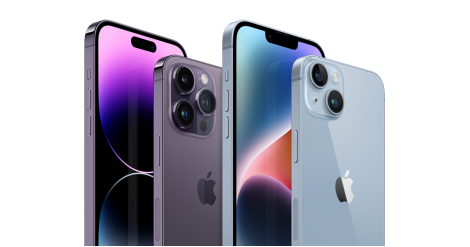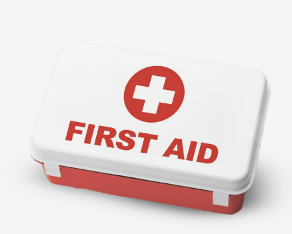Samsung Galaxy Tab S8 vs. Microsoft Surface Pro 8
Microsoft and Samsung produce some of the best tablets you can buy, especially considering the latest releases from both companies.
ContentsIf you’re looking for the differences between the Microsoft Surface Pro 8 and the Samsung Galaxy Tab S8, look no further. These two tablets run completely different operating systems but share some heritage, making them both enticing for the price. We’ve also included comparisons with the larger Galaxy Tab S8 Ultra for good measure.
Price
We start first with price, which is what matters most for your wallet. Microsoft’s Surface Pro 8 begins at $1,100, and that’s just the price of the tablet itself. This is the cost of a base model with an Intel Core i5 processor, 8GB of RAM, and a 128 GB SSD. If you want more storage or a faster processor, you can kick the price all the way up to $1,900 for a model with an Intel Core i7 processor, 16GB of RAM, and a 512 GB SSD. Mid-range models with the Core i7 processor, 16GB RAM, and 256GB of storage come in at $1,600.
With the Surface Pro 8, the Surface Slim Pen 2 and the Type Cover are not included in that price. If you want those for cheaper, a bundle starts at $1,528.97. That includes the base Pro 8, a Signature Type Cover (with the Surface Slim Pen 2), Microsoft Complete Protection, and Microsoft 365. Otherwise, the Slim Pen and Type Cover are separate purchases of $129 and $180 respectively.
Samsung’s Galaxy Tab S8 is a little bit different, as there are three different models. The smallest, the 11-inch Tab S8, starts at $700 and includes 8GB RAM and 128GB of storage. This can be kicked up to 256GB for $779. The 12.4-inch Tab S8 Plus, meanwhile, starts at $900, which includes 8GB RAM and 128GB of storage. For an additional $179, you can get 256GB of storage on top of that price. Finally, the 14-inch Tab S8 Ultra comes in at a $1,100 starting price, including 8GB RAM and 128GB of storage. You can bump it to 12GB RAM and 256 GB storage for $1,200 or 16GB RAM and 512GB storage for $1,400.
In Samsung’s case, the S Pen stylus is included with your purchase. Pre-orders on Samsung.com currently include the keyboard cover, too. Once launched, though, the Slim Keyboard Cover will be a separate purchase of $349 on the S8 Ultra and $140 on the standard S8.
In terms of price, the Galaxy Tab S8 series will definitely be a lot cheaper for most people. However, once you match the sizes of the devices, the Pro 8 and Tab S8 Ultra are almost on similar footing, close to $1,100. If you opt for the smaller S8, though, it will definitely save you money.
Design
Looking at the design, things seem similar at first. Both tablets are made of premium materials and are on even footing. However, the Surface Pro 8 will have one advantage over the Galaxy Tab S8, as we get into later.
In terms of design material, the Surface Pro 8 sports a signature anodized aluminum coating and comes in either graphite or platinum color options. The Galaxy Tab S8 series, meanwhile, sports what Samsung is calling “Armor Aluminum.” It comes in graphite color on the Tab S8 Ultra, or silver, pink, or gold on the Tab S8 Plus and Tab S8.
Generally, this design material means the tablets are on even footing in terms of weight. The 11-inch Tab S8 is the most portable variant, coming in at 9.99 inches by 6.51 inches by 0.25 inches, with a 1.1-pound weight. The 12.4-inch Tab S8 Plus measures 11.22 inches by 7.28 inches by 0.22 inches and weighs 1.27 pounds. The 14-inch Tab S8 Ultra is a mammoth, as it has dimensions of 12.85 inches by 8.21 inches by 0.22 inches and weighs in at 1.6 pounds.
The Surface Pro 8 comes close to that Tab S8 Ultra in weight at 1.96 pounds. But in terms of dimensions, the Surface Pro 8 is closer to the Tab S8 Plus at 11.3 inches by 8.2 inches by 0.37 inches.
Note that the Surface Pro 8 has a built-in kickstand, which gives it what gives it a big advantage. This makes the device more comfortable to use when you’re inking, watching movies, or using it as a laptop.
Samsung’s Galaxy Tab S8 series does not have a built-in kickstand. However, there’s a place on the back of the Tab S8 for the S Pen, whereas on the Pro 8, you’ll have to house the Surface Slim Pen inside the keyboard for charging.

Without that keyboard, you’ll have to buy a Slim Pen charging cradle for an additional $100 or opt for keeping an older Surface Pen with a built-in replaceable battery separately.
Looking at other design features, the Surface Pro 8 has some upgradability. You can pop out the solid-state drive from under the kickstand and install one of a bigger size. The Galaxy Tab S8 series doesn’t have this, but it lets you expand storage with a microSD card of up to 1TB.
In terms of the overall look of the device, the Surface Pro 8 has a more rounded design. The Tab S8 series is more squared off, like the iPad Pro. You’ll have to decide which is more comfortable for you, but both tablets seem to be even in weight — with the exception of the Tab S8 Ultra.
Display
If you’re considering just the displays when buying these devices, then we have your back. In summary, the Galaxy Tab S8 series will win out, as it has much thinner bezels all around, plus the option for AMOLED panels. The Surface Pro 8 is fine, too, with some additional features like support for haptics and a 120 Hz refresh rate.
Starting first with the LCD display on the Surface Pro 8, it comes in sized at 13 inches, with a resolution of 2880 x 1920, or 267 pixels per inch. Compared to the last Surface Pro 7, the bezels are slimmed significantly on this tablet. Plus, it also adds support for haptics, so when you rub your Slim Pen 2 on the screen, you get some slight feedback. The final notable feature is the 120Hz refresh screen, which we found brings Windows 11 to life and makes web browsing feel much smoother.
The Galaxy Tab S8 series is a bit more complicated if you look at the display since there are three sizes. The cheaper Tab S8 sports an 11-inch TFT LCD Display tuned to 120Hz and a resolution of 2550 x 1600. The Tab S8 Plus has a 12.4-inch AMOLED panel and kicks the resolution up to 2800 x 1752. Finally, the Tab S8 Ultra is at the top of the top with 2960 x 1848 resolution. All these displays have the same 120Hz refresh rate as the Surface Pro 8 for smoother scrolling and gaming.
The Tab S8 Ultra has the closest resolution to the Surface Pro 8, but note that the display is uniform with similar-sized bezels all around on the intro and mid-range Tab S8 models — with the exception being the Tab S8 Plus, which has a small notch up at the top of the screen. Also, keep in mind the standard Tab S8 has an LCD panel, which won’t be as vibrant as the AMOLED on the mid-range and high-end version. It’s the same kind of panel found on the Surface Pro 8.
All in all, the Surface Pro 8 might have support for haptics on its screen. It has some bigger bezels along the top and the bottom of the screen. It’s also sporting LCD panels, which aren’t as vibrant as the AMOLED panels on the Tab S8 series, which produce more vibrant and bright colors. We pick the Tab S8 here.
Performance
The Galaxy Tab S8 series and Surface Pro 8 are very different in performance. While the Pro 8 features a computer-grade processor and can be a desktop replacement for some people, the Tab S8 series is more of a mobile device that tries to replace your computer. Here’s a little more on why we say that.
With the Surface Pro 8, you’re getting a device with 11th generation Intel Core i5 or Intel Core i7 Processors and a familiar desktop experience powered by Windows 11. These are quad-core processors, that can power light photo and video editing. Intel’s Iris Plus graphics also mean that you can run desktop versions of Photoshop and not worry about the hassle of mobile-first apps. We liked the Surface Pro 8’s overall performance a lot and found that it lead the pack against other 13-inch laptops.
With the Galaxy Tab S8 series, things are a little more straightforward. All models share the same Qualcomm SM8450 Snapdragon 8 Gen 1 octa-core processor. These chips are great for mobile gaming and productivity and should power most Android apps just as fine as last year’s Tab S7. Samsung says it’s the fastest chip ever on a Galaxy Tablet, with a 52% faster GPU and a 24% faster CPU.
Now for the trick that Samsung has up its sleeves. While the Surface Pro 8 is a full-blown computer, the Tab S8 series features Samsung’s DeX mode. This mode lets you window and stack Android apps side by side in a desktop-like experience. So, if you’re coming from using Windows, that may entice you.
Portability
Finally, we come to portability. Here, we look at ports between the devices as well as connectivity. To no surprise, things are almost even here, but we give the win to the Pro 8 for its wider set of ports.
The Surface Pro 8 sports 2 USB-C Thunderbolt 4 ports, a 3.5 mm headphone jack, and a Surface Connect port. The Tab S8 series only has 1 USC-C 3.2 port and no headphone jack. So, while you’ll need to dongle up on the Tab S8 series to listen to music, you can spare one dongle for a headphone jack on the Pro 8.
As far as connectivity goes, both devices support Wi-Fi 6 and Bluetooth 5, but the Tab S8 series has the edge with Wi-Fi 6E and the slightly newer Bluetooth 5.2. There’s also an LTE model of the Surface Pro 8, but the Tab S8 Plus kicks up to include support for 5G.
With battery life, the Tab S8 sports an 8,000 mAh battery, the S8 Plus supports 10,090 mAh, and the S8 Ultra can do 11,200 mAh. The Surface Pro 8 does not have mAh listed for its battery, but last year’s Pro 7 came in close to 8,000. We don’t have solid numbers for battery life on the S8 series just yet, as we didn’t test it, but we got to around 10 hours on the Pro 8 when we reviewed it and wouldn’t be surprised if the S8 series is around the same.
Looking at cameras, the Tab S8 and S8 Plus a have pair of 13-megapixel standard and 6MP ultrawide sensors on the rear. The front-facing camera on both is 12MP ultrawide, but notethat the Tab S8 Ultra adds an additional 12 MP front-facing camera. As for the Pro 8, it just has a 5MP 1080p front-facing webcam and a 10 MP rear-facing webcam. The Tab S8 definitely seems like a better photography tablet.
In terms of security, the Tab S8 has a fingerprint sensor on the power button, but its bigger siblings have a fingerprint sensor on the screen. The Pro 8 has a Windows Hello IR scanner, which might be quicker for most people.
The price is close
Surface Pro 8 and Galaxy Tab S8 series are neck and neck. Both are premium tablets. The biggest deciding factor will come down to preferring Android or Windows, and that has less to do with these individual products. Thanks to its app ecosystem, the Galaxy Tab S8 will having a better touch and tablet experience. It’s also a much cheaper device.
The Surface Pro 8’s strengths lie primarily in its ability to replicate the complete desktop experience. With DeX, Android just can’t quite compete with the full functionality of Windows 11, even on a 2-in-1 like this.



